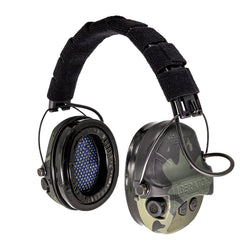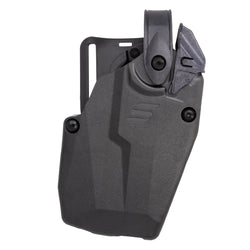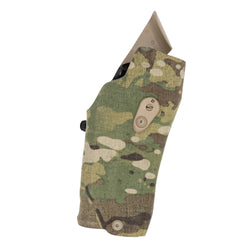Retention holsters were once primarily used by police and military, while civilian shooters typically relied on simpler designs. Today, retention holsters have become increasingly popular among everyday carriers. I guess you could say retention holsters are no longer the “specialty” but the norm.
Even with their growing popularity, many people don’t fully understand retention levels. Over the years, I’ve found that a lot of people who use retention holsters don’t understand what retention ratings mean. This includes some police, who use them for a living. I’ll be the first to admit, I carried a retention holster on patrol for years and didn’t have a clue. So what is the difference between Levels 1, 2, and 3?
We know that a retention rating refers to a holster’s ability to keep your firearm secure. But what defines a “level” of retention? The most popular belief is that it depends on the number of security mechanisms on the holster. For instance, one may assume that a self-locking system and an automatic locking system would result in Level 2, right? Nope. Those two systems together actually result in a Level 3 holster.
So, today, we are looking at the retention levels, but more specifically, which level of retention holster may suit your needs. First, let’s talk a little bit about retention levels and how they are determined, then we will get into what each level is good for.
What are Retention Levels?
Retention ratings were first established by Safariland as a way to measure a holster’s security. A Level 1 holster has one distinct retention feature and requires one hand movement to draw. A Level 2 holster requires two movements, and Level 3 requires three. Basically, these levels indicate the number of actions required to draw the firearm.
What Qualifies a Holster for a Retention Rating?
- The holster must be attached to a belt using an approved attachment system.
- A retention-rated holster can lose its rating if attached to a non-approved system.

For example, taking a Level 2 holster off a Safariland belt mount and placing it on a paddle attachment removes retention because the holster can be pulled off the person. Safariland holsters with a retention rating are generally in the 6000 or 7000 series and are designed for belt attachment.
What gives a holster a specific retention rating?
A security mechanism may require one or more movements to release the firearm. This is where the “level” comes from:
- ALS (Automatic Locking System) → one action = Level 1
An ALS is released by simply pulling back on the lever. This single movement earns it a Level 1 rating. - SLS (Self-Locking System) → two actions = Level 2
The SLS requires a button to be pushed down before the rotating hood can be pushed forward. Because two distinct movements are needed, it qualifies as Level 2. - Combined ALS + SLS → three actions = Level 3
When both systems are used together, the holster earns a Level 3 rating. Releasing the firearm involves three actions: first, push the rotating hood lever down with your thumb; second, push the rotating hood forward after pressing the button; and third, pull the ALS release lever to the rear with your thumb.
Each additional movement adds a level, clearly defining the holster’s retention rating.
What about passive retention?
Some holsters, like IWB or OWB concealment holsters, use “passive retention.” This relies on friction to keep the firearm in place but does not lock it. What you need to understand about this type of system is that it is not considered a “retention” rated holster.
Even though the holster is designed to put pressure on the gun to help keep it from coming out of the holster as easily, it is not “locked” in. Because of this, Safariland does not assign it a retention rating at all. For me, this makes perfect sense, and I am inclined to agree with them.

Retention Holster Levels Explained
Now that we have had a crash course in retention ratings and how they are applied, let’s move on to the good stuff: What type of holster retention do you need for your specific task?
Level 1 Retention Holster
A Level 1 retention holster offers basic security, requiring one movement to release the gun from the holster. For Safariland holsters, this would be the ALS system.

The primary benefit of a Level 1 holster is speed. Because it requires only one movement, you can draw faster than you can a Level 2 or 3 holster. This makes it a great choice for competitive shooters but also suitable for everyday carriers in low-risk environments.
And to clarify, I’m referring to a low-risk environment as an environment where you try to avoid danger. Police, for example, respond to incidents that would be considered a high-risk environment.
A Level 1 system provides a balance between security and speed. It offers more security than a passive-retention holster but can be drawn rather quickly. It’s a good entry point for those new to active retention.
Here are some examples of level one Safariland holsters that I have used in the past:
Level 2 Retention Holster
A Level 2 retention holster adds a second movement to release the gun from the holster. Safariland’s 6000 and 7000 series holsters with the SLS (Self-Locking System) fall into this category.
- Example: Safariland 6005 Duty Holster (Glock 17/22 with weapon-mounted light)
- Operation: To draw, you must push down on the hood release button and then push the hood forward. Once the hood is pushed forward, the gun can be drawn without restriction.
- Used by: Some police officers, armed security personnel, and many civilians wanting extra security.
The rotating hood covers the top of the gun when closed. Unlike an ALS, the SLS is not automatic—you must pull the hood back over the firearm after holstering to engage the lock. Once locked, the retention is active.

Level 2 holsters are still used by some law enforcement agencies, though Level 3 is now the standard. The key difference between the ALS and SLS is that the ALS is always active—you must pull back the lever every time you draw. The SLS can be left disengaged by pushing the hood forward and leaving it open, but this isn’t recommended since it makes the firearm more vulnerable to a gun grab.
Level 3 Retention Holster
Level 3 retention holsters provide the highest level of security. With the ALS and SLS combined, it takes three distinct movements to draw the firearm.

Examples of Level 3 Safariland holsters:
These holsters have become the most common choice for law enforcement today. Because officers interact with the public daily, they need maximum protection against an opponent attempting to take their firearm.
Security personnel in high-threat environments also benefit from this system. It’s designed for situations where a gun grab is a real and constant risk. When you work in close contact with people, this feature is essential. While the extra movements add time to the draw, the system prioritizes officer safety above all else.
One important factor to keep in mind with a Level 3 holster is the additional training it requires. Your body needs to build muscle memory to draw quickly, and that only comes with consistent holster practice.
Which one is right for you?
Deciding which holster retention level you need depends on several factors, including what you’re comfortable using. I won’t tell anyone what holster they need to use. But I will say a holster that is visibly worn on a belt should have some type of retention. This can help keep it from falling out, but more importantly, it keeps someone from grabbing it.
Safariland offers a wide range of holsters with all levels of retention, so check them out and see which holster works best for you. If you’re like me, you may want multiple holsters for different tasks and purposes. If that’s the case, try the QLS so the holsters can be moved around quickly on your belt, or multiple belts.
Frequently Asked Questions
What is the difference between active and passive retention? Passive retention relies on friction between the holster and the firearm. Active retention uses a specific mechanical device. This device must be defeated by the user to draw the gun.
Can I upgrade my holster’s retention level? No, you cannot upgrade a holster’s retention level. Retention systems are built into the holster’s design. This means you must purchase a new holster if you want to change levels.
Why do some holsters lose their retention rating when a paddle or other attachment is used? The retention rating applies to a secure system. A paddle attachment can be pulled off the operator. The rating is based on the entire setup’s ability to retain the firearm.
Is a higher retention level always better? Not always. A higher retention level offers more security. But it can also slow down your draw time. The best level depends on your specific needs and the environment in which you carry.









